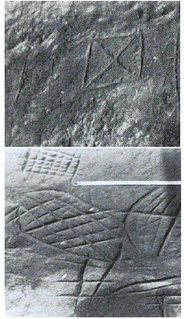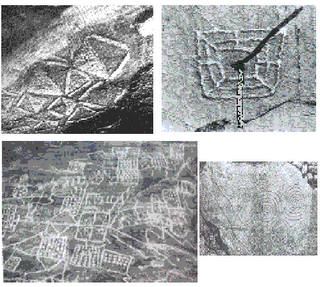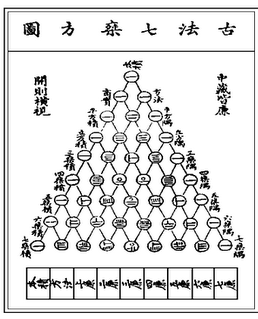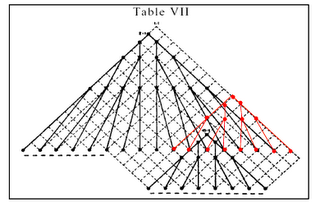Proto-Structure of Diamond Strategies
„Everything is true: not everything is true; both, everything is true, andBeyond names and propositions, again
not everything is true; or, neither everything is true nor is everything not true.
This is the teaching of the Buddha.“ Madhyamika Karika
Without getting lost into the deepness of philosophical and grammatological studies we can apply the mechanism of proto-structure, i.e., the activity of tetraktomai,i.e., to use the tetraktys, on a more common arena of emotive-cognitive organization in communicational situations. The Diamond Strategies are obviously operating beyond notions and statements, thus, if applied in therapeutic situations, they are not primarily a "talking cure" (Freud).
Our orientation in the world is mainly guided by sentence/notion based thematizations. To diamondize, like to tetraktomize, is to abstract and to subverse this semantic level of thematization in favor of its dynamic patterns, i.e., the morphograms of interaction/reflection of communication.
The process of morphic abstraction is pushed by questioning the existence (ek-sistenz, Heidegger) of the communicand (client).
The existence is what can be abstracted from the historic and local stories of the person involved. But such an existence is not identical with an identical kernel of a self or ego of a person(a) (mask).
In Ancient time of Pythagoras and the Chinese and Indian thinker, this procedure was not an abstraction but the genuine and direct way of approaching reality.
In a form, reduced to logocentric purposes, the diamond is well known in the West since Aristotle as the Square of Oppositions, and it had many modern applications in logic (Belnap, Fitting), psychology (Piaget), semiotics (Pierce), linguistics (Greimas), etc. Today general studies of the "Square of Oppositions" are promoted by the Universal Logic group which is running its 2nd World Congress at Xi'an, China.
Obviously, the Diamond Strategies are not excluding such logical studies of the Square but are not to gather under their umbrella.
There are many existential and emotional strategies today to defend ones established attitudes against a new way of thinking and thematizing the world. One is well documented in the Gödel-Günther-Correspondence.
To overcome such barriers, the Diamond Strategies always had been of great help.
Proto-Structure of the Diamond Strategies
Also deconstruction is not simply a method, Derrida gives us some general strategies of deconstruction.
Reversion of hierarchy
"In a traditional philosophical opposition we have not a peaceful coexistence of facing terms but a violent hierarchy. One of the terms dominates the other (axiologically, logically, etc.), occupies the commanding position. To deconstruct the opposition is above all, at a particular moment, to reverse the hierarchy." (Derrida, Positions, 56-57).The double gesture displacements
"Deconstruction must through a double gesture, a double science, a double writing, put into practice a reversal of the classical opposition and a general displacement of the system. It is that condition alone that deconstruction will provide the means of intervening in the field of oppositions it criticize and which is also a field of non-discursive forces." (Derrida, Marges, 392)Interestingly, the Diamond Strategies are incorporating both Ancient attitudes:
1. The tetralemmatic and tetractic way of conceiving truth (Buddha, Pythagoras), and
2. the pragmatic or praxeological apraoch of Chinese thinkers to the relevancy of statements as opening futures instead of claiming eternal truth.
Let us play the game of the Diamond Strategies
From the frozen attitudes of our hierarchical thinking and feelings to the endless flow of inventing and co-creating our futures in the open chiasm of systems of multiple opposites.
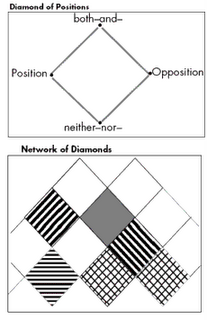
Step one: Position (Problem, Conflict)
Describe your state or situation of the moment with a good, short but precise statement. It´s your statement of position, affirmation, it´s your starting point of the game.
Question1: What is the situation/constellation you want to explore/re-solve?
Go with your personal starting statement as deep as possible into your emotional and/or cognitive state. Ask yourself about your state formulated in your first starting statement. Elaborate the semantical and emotional context of this statement. Take your last/best sentence of your exploration of your feelings and thinking of your situation and write it down.
Step two: Opposition (Subversion, Solution)
Create the opposite of your state, of your belief statement, of the sentence which describes your situation most concrete.
Question2: What is the opposite of your starting position?
Our language gives us a lot of possibilities to build opposites: logic, grammar, semantics, word games, phonetics, writing, gestures etc. It´s not only negation, you also have inversion of all sorts of order in a sentence or between sentences, dualities, reflections, mirroring and many other methods of translating a statement into it´s opposites.
Example
Position: Nobody loves me.
first opposite: Everybody loves me.
second opposite: Everybody hates me.
third opposite: Everybody loves you.
I would like this one as a nice opposite of "Nobody loves me." :: "I love anybody."
What are the connections between the position and the opposites? You are discovering a Semantic Field of statements between position and its oppositions.
Third step: (neither-nor-): sovereignity
Change between your two states (position vs. opposition). Take position and all feelings for the one, and then take all feelings and surely also all thoughts for the other one.
Question3: What's your neither-nor of position/opposition?
Change and feel what happens when you are changing from position to the opposite. Play this transition game as often until you feel and think that both are equivalent (like light/shadow). Then you will feel immediately that you are free from both: you are not the one and not the other.
You as a subject, as a person you are neither this nor that. This insight and this feeling, that you are not identified with one of the sides of the opposite is your third position. Here you are free, you have the most possible distance to all of the world. Then, how do you see the two other positions, how do you feel them? Go back to the first and to the second. Which do you like most? Play the game until you feel all three positions as equally relevant. All three belongs to you.
Fourth step: all of that at once - pure richness
But this is not all we can do. We can also have the opposite of this distance and sovereignty of the 'neither-nor'. It is the fourth position of 'both-at-once'.
Now you have often changed your positions and you had have very strong feelings and insights in this three positions and transitions. You will discover that all this belongs to you. And not only one after the other but all at once. You are all that at once. You are both position and opposition.
Question4: What is your both-at-once of position/opposition"?
Re-Solution
Then you make the complete trip: you go around the 4 positions in at least 6 primary steps, you have 24 permutations of your primary steps- that's your universe of experience(s) at this very first step within the Diamond Strategies.
Exploration
Each station of the Diamond elaborated serves as a new starting point (Position) for further diamondized explorations of your complex emotional/cognitive space.
With the game of the Diamond Strategies you have deliberated yourself from your fixation on one point of view in describing, reflecting, feeling, deciding, organizing etc. your life, your future of your organization or company.
Opening existential futures: Enabling vs. disabling
All of the four positions of the first Diamond Strategies can be asked about the future possibilities, about their perspectives, about their horizon of new behaviours, etc.
You can ask: What enables me this, which are the new possibilities for me, what new chances are opened up by this state, position etc. for me.
First Step: Enabling vs. disabling
Take one of the 4 positions of the Diamond, then ask one of the questions about enabling/disabling.
1. What is the position enabling/disabling,
2. What is the opposition enabling/disabling,
3. The neither–nor– of enabling and disabling,
„What neither enables nor disables me A?“
4. The both–and– of enabling and disabling,
„What both at once enables and disables me A?“
Second Step: Iterations
You can also freely repeat and alternate your questions about enabling and disabling, thus producing a grid of enabling/disabling positions.
Diamond Strategies of Thematizations
After the more existential application of the Diamond Strategies we are applying them onto the linguistic and grammatological situation of notion/proposition.
Designing the Diamond
A possible Diamond of notion/sentence can be established as:
Notion: name-based conceptualization,
Proposition: proposition-based thinking,
Morphogram: neither name nor proposition,
Inter-textuality: both at once, name and proposition.
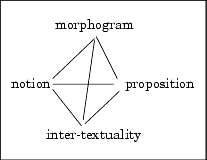
Iteration of the Diamond
notion–––>proposition–––>notion
Accretion of the Diamond
proposition as position, new opposition could be text.
morphogram as position, new opposition could be image.
inter-textuality as position, new opposition could be medium.
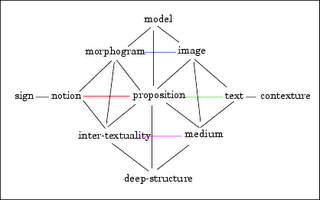
The diagram shows a possible accretion of the first diamond. There is no strict necessity to develop the diamond this way, other decisions for an interpretation of the knots can enter the game, producing other interpretations of diamonds.
Diamondize vs. Syllogisms
Trees are graphic representations of the notional entailment relation which is at the base of logical thinking, deduction, not restricted to Aristotelian syllogism only.
It is of importance to understand that such an accretion is not building a subordinating order, like a diaeresis, thus, it is not a pattern founding deduction, syllogism and linear or tree-like conceptualization. The knots of this diamond, understood as a proto-structure, can be themselves starting points, origins, for binary trees.
Because of its commutative structure, the graph of the proto-structure is a grid and has neither an origin nor an end. Thus, it might be slightly misleading to write the proto-structure with a beginning (1:1) as it is presented in Gunther’s papers. This happens for notational purpose only.

